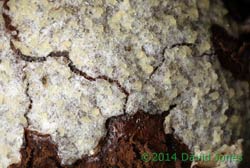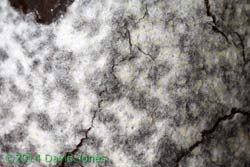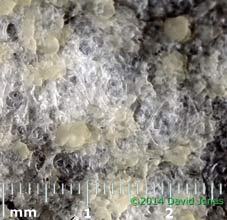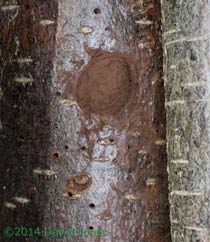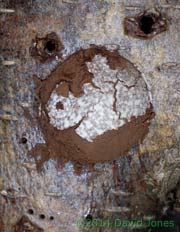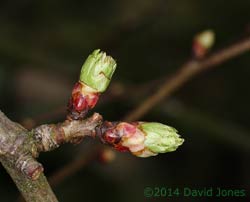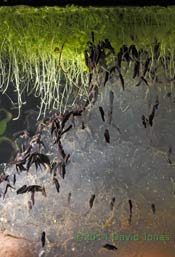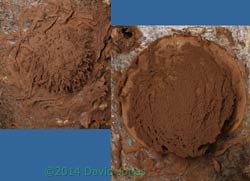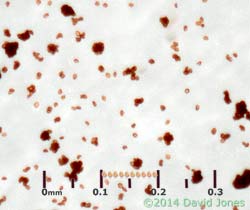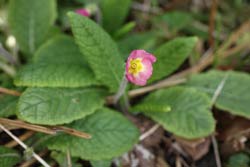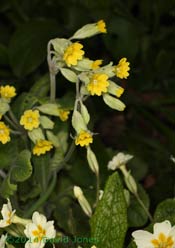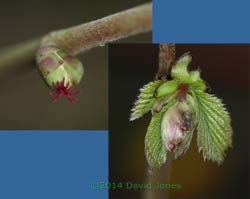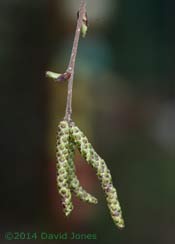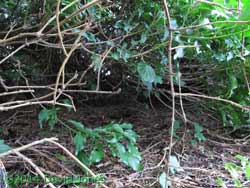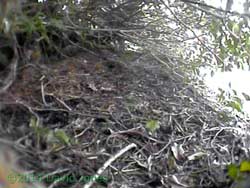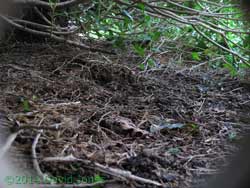Go to the last entry on this page .....Go to previous entry16 March - Another cloudless day when the temperature passed 18C. Following on from yesterday's observation of the two slime mould sporangia I've taken some close-ups of the epidermal layers. This shows some detail of the south-facing sporangium, showing how the surface is covered with cream-coloured globules above a white base.
In contrast, the north-facing sporangium appears whiter because there are far fewer (and paler) globules which are also smaller. Both pictures were photographed at the same scale.
Looking more closely at the north-facing sporangium (x9 magnification) revealed the white surface to have quite an interesting structure - perhaps a gooey/slimy texture, although at first glance it appeared to be a dry surface.
17 March - after all the sunshine of previous days, today was a bit of a disappointment, with cloud cover until after dusk, a cool westerly breeze, and a high temperature of 'only' 13C for a short time in the early afternoon.
By this morning both slime mould sporangia had started to shed their spores, the south-facing one having lost completely its epidermal layer.
The north-facing sporangium still had half its covering remaining at the end of the day. I've collected spore samples from both structures and will take a close look at these later in the week.
And before I forget once more, the wood is a multi-branched piece of cherry, which has been stored upside-down, as seen in this picture. The wood is now extremely fragile, several of the branches having broken off over the last few years.
Something I nearly missed this morning - the leaf buds on our Hawthorn have now started to burst, nearly a month earlier than in 2013 when I recorded it happening on 14 April. Also, the first violets opened today, and in 2013 they were also seen open for the first time on 14 April!
Yesterday, our grandson was able to see the tadpole embryos making occasional tail movements within the frog spawn. Today, much to the delight of both him and one of his cousins who spent the morning with us, all the tadpoles left the refuge of the gelatinous mass that had protected them during their early development.
18 March - A cloudy, cold feeling day thanks to a brisk westerly breeze. The official high at Farnborough airfield was 13C at 2pm, shortly after we experienced a short rain shower. It was a busy day with a very active grandson, so there was just one observation made in the garden, a follow-up on yesterday's report on the slime mould. By today the second sporangium (on the right) had lost its epidermal layer and by the time I took these photographs this evening the to structures had shed a good proportion of their spores. As the spores are lost a filamentous structure is being revealed which I must presume formed the framework on which the spores developed.
19 March - A dry and sometimes bright day with the temperature hovering around 15C for much of the afternoon, probably thanks to the breeze swinging round to come from the south-west.
Just one image today. I had time to photograph a sample of the spores from the slime mould. Taken at a magnification of about x19 the picture does not have the sharpness that I would have wished for. However, it was clear enough to distinguish individual spores which appear to be somewhere between ovoid and spherical in shape. As you can see, many of the spores are clumped together.
To get a better idea of their size I've copied the image of a typical spore and copied it to form a row of ten which you can see superimposed on the scale. This gives a spore size of just under 0.01mm (10µm), which is in line with sizes between 5 - 13µm that I seen given in other sources. Slime moulds are members of neither the plant nor animal kingdoms. They are instead classified as being in the Kingdom Protista, and exhibit characteristics of both animals and fungi. I'm not going to attempt an explanation of the complex life history of a slime mould, but a straightforward description can be seen here. Today's exercise demonstrates to me the need to look at the possibility of getting a half decent microscope lens for this sort of high magnification photography - perhaps later in the year....
22 March - A showery day with some bright spells and a constant breeze from the west south-west keeping the maximum temperature below 10C for much of the day - typical of the last couple of days.
This plant first made its appearance on 6 March 2007 and since then has bloomed on the following dates in March (no date recorded for 2013) - 15th, 10th, 26th, 21st, 11th, ?, and now the 22nd.
26 March - The last few days have seen the temperatures remaining below 10C, with showers that have included hail and a bit of sleet. Today the maximum was 8C, with a north-easterly breeze making it feel appreciably colder and tonight the temperature was down to 2C by 8pm. It looks as though it will be a frosty night so the tadpole tank is now covered with a quilted, waterproof jacket! On the coming weekend we could once again get temperatures of near 20C, thanks to a change in the wind direction.... The tadpoles in the tank are now free-swimming, much to the delight of our grandson, and this morning I had a treat in store for him after breakfast. With the tadpoles in the pond also becoming mobile now, the Common newts are starting their Spring feast, and last night I counted six of them stalking their tadpole prey. I took the opportunity to catch a female to keep it overnight in a nearly clear plastic tub half filled with pond water (and a few tadpoles). This morning Evan spotted it through the window, and as soon as we were both in warm coats he had his first encounter with a newt - another one of those magic moments followed. I wet my hands and allowed the newt to crawl over them. Evan was thrilled to be able to touch it very gently and watch its skinny legs as it moved about. When it was time to return the newt to the pond that was Evan's job. He carried the container down the path and to the far end of the big pond where he knelt down and very carefully poured the contents into the pond, watching as the newt swam away. I must get a small, clear tank so that next time we do this he will be able to see a newt swimming clearly.
Two plants had managed to flower for the first time on Sunday. There was the first bright yellow flower of a Marsh Marigold, and the speckled purple bloom of a Snake's head Fritillary. There should be good displays by both species over the weeks to come, and in the case of the Fritillaries there are lots of young plants growing but which look as though they will probably wait until next year before flowering.
One plant species I've overlooked during the last week or so has been the Cowslip which is well into flower in several spots. Also, today I spotted several Ground Ivy flowers which must have started opening in the first half of this week.
We have two Hazels which are (apparently) the same age. However, it is interesting to see a difference between them at the moment. In the last week of February I reported on how one of the Hazels had quite a few female inflorescences, coinciding with the release of pollen by just two clusters of male catkins.
That is in marked contrast to the other tree, on which I can see no flowers but instead there are now numerous clusters of young leaves low down on the plant. I still have some pollen left from the first tree. Perhaps I will dust some more of the female flowers tomorrow.
Our Himalayan Birch isn't quite ready to flower as yet. The male catkins are tightly closed and I cannot see any buds on the point of bursting as yet.
28 March - After another cold day yesterday, there has been an improvement. After a misty start with a couple of showers the rest of the day remained dry with the temperature remaining at or above 10C all afternoon, with a high of 12C thanks to the breeze moving around to the south-east for a while. Today I finally made a start with switching on cctv cameras, starting with those at the bottom of the garden. I headed for the Blue/Great Tit nestbox 'tower' only to find that the nest box itself shows no sign of any visits having been made, the entrance partly blocked by cobwebs that must have been in place for some time. At one point I went into the timber store next to the tower and was surprised by sudden movements above my - an animal moving about before jumping up onto the tower. It had to be 'our' fox. Once it was all quiet again I propped a ladder against the front of the tower to clean the lens of the camera that is used to monitor the site sometimes used by the Blackbirds for nesting. This time the fox jumped from the tower roof onto the log store and I was able to see it for the first time as it walked to the end of the store, climbed down to the ground and disappeared behind the store as it headed into next door's garden. The encounter had me wondering, and I took a look at the roof of the timber store. This was constructed with deliberately strong supports so that it would be able to support a thin layer of soil or decaying plant matter. Where the roof meets the boundary fence at the bottom of the garden I made provision for Ivy to grow up above the roof. This is watered whenever it rains, the water being collected in a water butt with an overflow pipe discharging its flow around the Ivy plants.
Anyway, the Ivy has now formed a canopy that overhangs the roof, providing a sheltered area with a soft floor where I think the fox had been resting before being disturbed. This picture shows a rather restricted view of that canopy. I hope to take a better photograph during the weekend.
With the Blue Tit box inactive I decided to use the camera that normally points into the nest box from the rear (there is still a camera inside the box should any birds decide to move in). This is the image that I now have of the sheltered area under the Ivy. At the moment the camera has a vide angle lens, but I may chance this once I see how much of the area is actually being used.
Just above the centre of the CCTV image there is an area where the plant debris has been somewhat hollowed out. This is a picture of that area taken through a second small hole cut in the tower wall. It's possible to make out a raised bank of material on the far side of the hollow. During the weekend I hope to look at the feasibility of setting up a camera support that will allow me to take photographs through the hole if and when the fox is present.
Back in the house the feed from the 'fox' camera will be recorded each day (no night-time images possible with the colour CCTV camera). Tomorrow I'll also connect the Blackbird camera to a recorder. My plans rather fell apart for a while this afternoon when i found that the Blackbird camera feed wasn't getting to the house, and the fox camera feed was intermittent. It didn't take too long to discover the cause - a couple of cables had been cut/chewed right through and several feet of coiled cable had lost long chunks of insulation and quite a bit of the copper screening cable. The size of visible teeth marks strongly suggest the culprit to be one or more rats. The cables were definitely on good condition after Christmas and I'm guessing the unwelcome guest(s) may have been encouraged to visit thanks to the very wet conditions at the beginning of the year. The really annoying thing is that those cable have been routed in the same way for years without any problems. Temporary repairs are now in place but I will need to do that job properly in the near future. Curiously, it was only cable with black insulation that was damaged. Orange coloured cable that was coiled up in the same place was not damaged at all.
Click on images to see larger version
|
|
